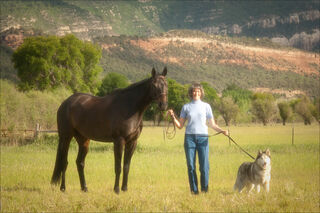Sport and Competition
How We Communicate with Horses
What can horses teach us about communication between species?
Posted April 14, 2021 Reviewed by Gary Drevitch
We snuggle up to our cats on rainy days and fall on our knees when our dogs greet us at the door. Pets have become emotional touchstones for many, supplying the unconditional love and affection that other family members sometimes forget.
Americans spend $67 billion a year on dogs, cats, birds, and horses, a total that has increased every year since 1994. Dogs and cats sleep in our beds, join us on vacations, and sprawl across the front seat of the car. Dogs enjoy play dates with their friends, often participating in more social activities than their “owners” do.
Horses, of which there are over 9 million in the U.S., are companion animals and performance partners. Many are groomed to a high shine every day, master complex athletic feats, relax under warm showers, and cruise around in trailers for excursions away from home. They exercise their owners and help to relieve emotional ailments like PTSD. And some are flown around the world for competitions, returning home to personal swimming pools and air conditioned stalls.
As animals morph into family members, owners become more interested in communicating with them. When Real Simple magazine asked readers which one technology they want that has not yet been developed, one responder said that what she wants most in the world is “a translation collar for my dog” so she could understand his intentions. Several artificial intelligence applications, like “Bowlingual,” “WhatsYapp,” the “Catterbox,” and “Petspeak” have attempted—unsuccessfully—to do just that.
To develop deeper interactions with companion animals, what we really need is an understanding of how their brains work. Often, our egocentric human minds assume that we know what our dogs and horses are thinking. (Cats? Not so much.) These assumptions are often wrong, though, falling into anthropomorphic expectations that allow us to imagine our furry friends are just like us. In fact, our pets experience the world, learn, communicate, and respond in very different ways than we do. Handlers who recognize and apply these differences can develop profound bonds of trust and communication with their animals.

Far more than dogs and cats, horses demand a high degree of brain-based, cross-species communication. One reason is their size: We cannot simply tell an untrained 1200-pound horse what to do. It’s not like pressing on a puppy’s hips and saying “sit” in an ever-louder voice.
A second reason is equine flightiness and agility. Horses are prey animals who have survived for the past 35 million years by noticing the tiniest cues to risk and fleeing immediately. Even the largest horses, like Clydesdales, can spin and bolt out of a position of total calmness in less than a second.
Third, if forced, horses who cannot flee from potential danger will fight. They bite, kick, and strike, each movement having the power to kill a human being in one swat. To stay safe, equine handlers are forced, to greater degrees than dog and cat trainers, to predict how the horse’s brain will react to various events. We have to develop strong means of cross-species communication to keep ourselves alive.
Human interaction with dogs is better known, but horses and humans represent a much better example of cross-species communication. Performance horses and equestrians communicate with each other moment-to-moment and brain-to-brain, in the most direct fashion of any animal/human team, because their bodies are in constant contact while riding.
Next, we’ll talk about the extreme athletic versatility achieved through brain-to-brain communication between horse and human, and some examples, as well as how that communication works at the level of neurons in both species’ brains.


